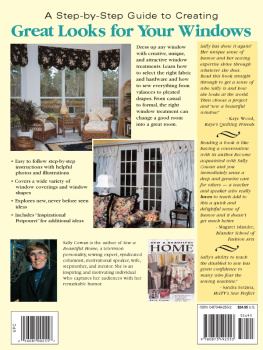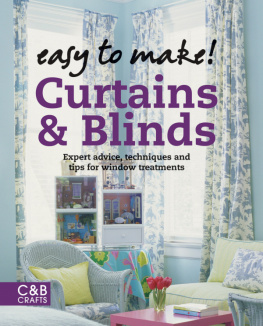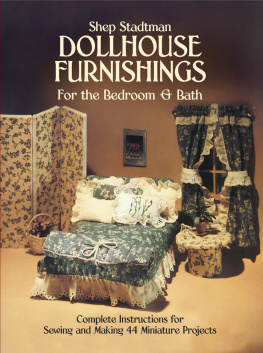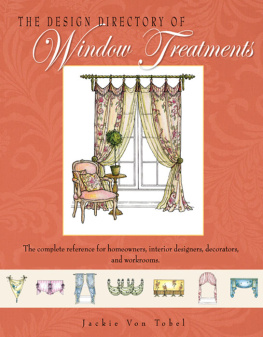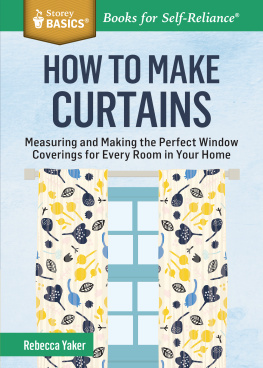CONTENTS

Choosing a Style
Window treatments have tremendous impact on your homes dcor. Considering how much space window treatments take up, their color and pattern have as much or more influence over the decorating scheme of the room as the furnishings, wall dcor, and artwork. The ambiance of the room is reflected in the style of the window treatment, from casual fabric roller shades to formal pinch-pleated draperies and lots of choices in between.
In the overall decorating budget, window treatments often cost more than the furniture, especially when the treatments are custom designed for you. You can reduce those costs by half if you make them yourself. You dont need professional sewing skills to get professional results. Even though some styles require long expanses of fabric, most window treatments are easily made with just straight seams and hems. Even complex-looking pleated draperies are easy to make when you follow the directions and photos in this book.
The choices for DIY fabric window treatments include top treatments, curtains and draperies, and shades. Any of the designs in this book can be used alone, especially if a simple, casual look is what you want. Some shade stylesclouds, balloons, and hobbleddo very well on their own. Top treatments by themselves soften the window frame and add color and style. That might be your choice for a laundry room or over the kitchen sink. Most often top treatments are paired with shades, curtains, or draperies, where they not only embellish the look but hide clunky lift mechanisms or other hardware. The more layers there are in a window treatment, the more formal it becomes. Goblet-pleat draperies over sheer curtains might be your choice for a master bedroom. For your living room, you might choose flat Roman shades with rod-pocket side-panel curtains topped off with box-pleated valances.

FUNCTION
Consider what you want your window treatments to do for the room. At the very least, they disguise the hard surfaces and angles of the windows with soft, graceful folds of fabric. Some treatments must block or screen the light that enters the room and provide privacy. These usually need to open and close by sliding back and forth on a rod or raising and lowering. If the treatment is simply decorative, it can hang over the top of the window frame, be drawn back to the side, or hang over the sides of the window frame. If the window is frequently opened and closed, choose a design that gives you easy access to the window.

For most of the treatments in this book, you have the choice of making them lined or unlined. Lining gives curtains, draperies, shades, and top treatments more body and protects the fabric from sun damage. It can also prevent light from shining through the fabric and making seams more visible. Of course, if sheer or semi-sheer curtains are what you have in mind, they should be unlined.
FORM
Like the rest of your home, your window treatments are a reflection of you and your favorite decorating style. There are styles to match any mood and decorcasual, fun, upbeat, contemporary, trendy, classic, formal, traditionaland hundreds of possible fabrics, rods, and trims to make your window treatments unique.
What length should you make your treatment? There are suggestions and examples for each style. In general, sill-length curtains are very casual, suitable for kitchens, bathrooms, and bedrooms. Floor-length, breaking on the floor, or puddling on the floor are all more formal. Use these lengths for the living room, dining room, or master bedroom. If your curtains are intended to open and close, however, avoid the puddles.

How to Use This Book
Here are instructions for fifty different styles of window treatments that you might use for your home. Some are classic styles that have stood the test of time and some are more contemporary and trendy. Photographs show each style in a variety of room settings with different fabrics, embellishments, and hardware. Youll see how decorators have approached common window shapes and locations as well as unique arrangements and sizes.
Once you have chosen a style, the step-by-step instructions will tell you how to construct it from beginning to end: measuring, cutting, sewing, and installing. It is a good idea to read all the instructions before you start. The What You Need to Know section in each project will help with planning; it covers information like what size to make the treatments, what types of fabric are suitable, and how and where to mount the hardware.



